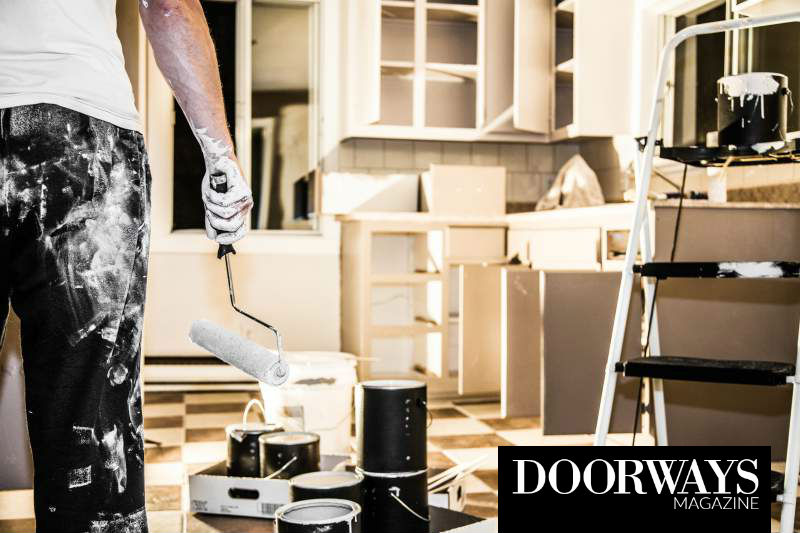Wed, Nov 28, 2018
Article may contain affiliate links. As an Amazon Associate I earn from qualifying purchases.

Want a kitchen makeover without spending a fortune? In this guide I’ll show you how to paint kitchen cabinets on a budget.
Some of the most common questions I get from readers are about painting kitchen cabinets. They always want to know the most popular kitchen cabinet colors and if painted cabinets will improve their home value.
Want to know the answers to these questions, too?
The good news is that you can paint kitchen cabinets over a few weekends for only a few hundred dollars. And a simple kitchen makeover could improve your home value instantly.
The bad news is that there’s an overwhelming amount of information available online about how to paint kitchen cabinets. If you take the wrong advice you could end up with a DIY disaster on your hands.
Painting Kitchen Cabinets Like a Pro
Painting kitchen cabinet is an easy way to get the look and feel of brand new cabinets without the cost. If you’re willing to do the work yourself, you could save a serious pile of cash.
The best part is that a minor kitchen remodel could increase your home value by almost $18,000! Not bad for a weekend project.
But, before you start slapping on coats of paint there are a few things you need to know. _And I mean really important things. _
If you want to know how to paint kitchen cabinets without having to worry about making expensive mistakes, you’ve come to the right place.
I’ve put together my best tips on painting cabinets into an actionable guide.
Inside you’ll get answers to these questions and more:
How many times you ACTUALLY need to sand kitchen cabinets
The secret ingredient you need to buy before you start painting
A simple organizing system that will keep you from pulling out your hair
The magic number that will tell you if your cabinets are safe to paint
Why kitchen cabinet colors are more important than ever before
and so much more…
As a bonus I’m giving away a free printable shopping list to my readers. It includes a list of everything you need to paint your kitchen cabinets this weekend. Print it out and start shopping.
Step 1: Remove Cabinet Doors and Hardware
Before you start painting you’ll need to set up your workspace and get all of your materials ready.
Preferably, you should dedicate a place in your garage to prep and paint your cabinet doors and drawers. You’ll need plenty of space where the doors can dry between coats of paint. If you don’t have room in your garage, your prep space should be away from the main traffic areas of your home, clean and dust-free.
Now it’s time to start disassembling your cabinets. First, carefully number each door and opening. You can do this by placing a numbered piece of tape to the back of the door and inside the corresponding cabinet. Numbering the cabinets will ensure they return to the same location when you are finished painting.
If reusing cabinet hardware, place hardware in numbered bags (corresponding to the cabinet door number) so you can reinstall in same place as well.
Place the cabinet doors on saw horses in your garage where they will be sanded and prepped.
Step 2: Clean Cabinet Doors, Drawers and Boxes
I’ve seen one mistake repeated many times while painting kitchen cabinets over the last few years and I’m sure I will see it again.
Chances are you’ll make this same mistake.
The sad part is that if this happens while you’re painting your cabinets you may need to start over from the beginning. A waste of time and money, if you ask me.
So, how can you avoid this mistake completely?
It all starts with a simple cleaning solution called Trisodium Phosphate.
You can find it at your favorite home improvement or hardware store. While the name sounds complex, it’s actually just a simple cleaner that makes your job 10 times easier.
After you remove your cabinet doors and hardware, carefully clean the cabinets using Trisodium Phosphate mixed with warm water and a sponge.
If you don’t completely clean the cabinets you will be seriously disappointed with the results.
Getting professional results requires preparing like a pro. There’s no doubt that you can get high-quality results from painting your own kitchen cabinets, but the quickest way to failure is by taking shortcuts.
Take your time and the results will follow.
While you’re cleaning you may notice that grease and dirt tends to collect in the corners of cabinet doors and along the edges. This residue might not be easily removed with just a sponge. Try using a small tool or putty knife to clean out these areas before priming the cabinets.
Step 3: Prep ALL Surfaces
After you’ve cleaned the cabinets and let them dry, the next step is to touch up any dents or scratches with wood putty.
These small imperfections may not be visible on wood cabinets, but after you paint they will be extremely obvious. Use a wood filler or putty to fill any scratches on the surface before you begin sanding.
Be sure to fill in any open seams along the edges of the cabinet doors and trim.
These gaps may not be obvious on dark wood cabinets, but once painted they will rear their ugly head. Squeeze a thin bead of latex caulk into these open seams and pull the tip as you go. Use a damp finger to smooth the caulk after it’s applied.
You’ll also need to fill in any hardware holes that will not be reused (if using new hardware).
After all imperfections are filled with wood putty, it’s time to start sanding.
Use a 120-grit sandpaper to sand the cabinet doors, drawers and base surfaces. Sanding is critical if you want a smooth paint finish that lasts forever.
After you go through the process of painting your cabinets, I’m sure you’ll never want to do it again. So, get it right the first time!
Prep work is the extremely tedious but it is also the most important part! Don’t take shortcuts!
When you are finished sanding use a tack cloth or handheld vacuum to completely remove any dust from the surface.
Note: Are you painting old cabinets? Be very careful before you starting sanding. If your cabinets were painted before 1978 they likely have lead in them. Learn more here
Step 4: Apply Primer
To get great results, I suggest using a “high build” oil based primer first. A high quality primer is important to help you get a nice smooth finish.
You don’t want to see the wood grain texture through your paint when you’re finished. Oil paint is self leveling and will give you a solid foundation to paint on.
If you prefer to use a more environmentally friendly primer, there are a few latex alternatives. When you visit your favorite home improvement store, just remember to look for a stain-blocking primer that is designed for high gloss surfaces.
Step 4: Sand
Hope you’re energized and ready to get back to work because it’s time to sand again. After applying primer, you’ll need to sand the painted surfaces again to ensure you’ll have a smooth finish.
Sanding will help your final coat of paint stay looking great for years to come. You’ll guarantee there will be no peeling or flaking. Plus, sanding will remove any paint imperfections you notice after the primer has dried.
Although most high quality primers are self-leveling, you’ll still want to make sure that there are no noticeable brush strokes or paint runs.
Step 5: Paint
Now we’re ready to start painting. Use a brush or high density foam roller. Begin in the center and work your way out toward the edges.
If wood grain still shows through, you’ll need to apply multiple coats until the underlying color disappears.
So, what kitchen cabinet colors are guaranteed to look great decades later? How do you avoid colors that will go out of style only a year later?
The answer is here: 5 Popular Kitchen Cabinet Colors That Are Also Timeless
These are extremely important questions, as thousands of dollars are spent each year to cover up the mistakes of “Purple Periwinkle” or “Totally Teal” colored kitchen cabinets.
The linked article includes a few color palettes that are designed to be timeless and help you get the most out of your kitchen remodel when you put your home on the market.
When you decide to update your kitchen, choosing the right kitchen cabinet colors is essential to building home equity and improving your home value.
Step 6: Reinstall Cabinet Doors and Hardware
After the paint has completely dried, it’s time to put your kitchen back together!
If reusing hardware, reattach door knobs and hinges in their original locations. Otherwise, carefully install new hardware using a template to make sure all doors match perfectly.
I recommend penciling in hardware locations before you start screwing the pieces in. This will give you visual first and alert you to any possible mistakes before you drill holes into your beautiful new cabinets.
Want to keep your cabinets looking great for years to come? Make sure you wipe them down regularly to prevent grease and grime build up.
Have Questions About Painting Kitchen Cabinets?
This is a quick overview of how to paint kitchen cabinets over a few weekends. Obviously, everyone will face different challenges while painting their cabinets. If you have specific questions, feel free to reach out on Facebook.
Don’t forget to download my free shopping list before you head to the home improvement store.
READ NEXT
